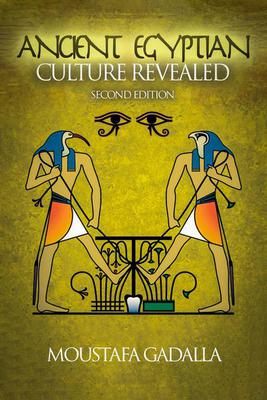The Actual Incredible Remote Age Of Ancient Egypt
1. The Rising Valley
Egypt is (and was) one of the most arid areas in the world. More than 90% of Egypt consists of desert area. Only about 5% of the vast country is inhabited, along the banks of the Nile and its branches. This fertile Nile Valley is a strip of 7-9 miles [11-15 km] wide.
The Nile flows through Egypt from south to north. That’s because the country slopes downhill towards the Mediterranean Sea. North of Cairo, the Nile splits into several tributaries that constitute the delta—a wide green fan of fertile countryside some 6,000 square miles [15,500 sq km] in area.
The River Nile in Egypt received (and continues to receive) 90% of its water during a 100-day flood period every year, as noted by Herodotus in The Histories, [2, 92], where he states:
. . . the water begins to rise at the summer solstice, continues to do so for a hundred days, and then falls again at the end of that period, so that it remains low throughout the winter until the summer solstice comes round again in the following year.
The flood waters of the Nile come as a result of the rainy season in Ethiopia, which erodes the silt of the Ethiopian highlands and carries it towards Egypt along the Blue Nile and other tributaries. No appreciable amount of water arrives to Egypt via the White Nile, which starts from Central Africa. No silt is carried by the White Nile—hence the name “white” means clear.
The muddy seasonal rushing water of the Blue Nile slows down as it reaches Aswan. As a result of the slowdown, the silt in the moving water settles to the bottom. This causes the bed of the river to gradually rise from time to time; and the level of the land, which always keeps pace with that of the river, increases in varying degrees according to the distance downstream and the variant topography of the land. This in turn causes the groundwater table to get higher as the water surface increases in elevation with the increase in the elevations of the Nile Valley and its surrounding lands.
So, if we look at these diagrams, we will be able to illustrate the situation.
The first diagram shows how a certain amount of water flowing in the Nile channel can reach the water surface elevation as shown.
The second diagram shows us how, when the water slows down, the silt will settle at the bottom of the channel, which will lead to a reduced area for the water flow. As a result, the water will go over the banks. The silt in the water will then settle on the banks of the channel.
The following year, the same thing will be repeated.
From here, we can see that the elevation of the Nile Valley increases every year as a consequence of annual floods during the summertime. These little-by-little accumulations add up, over the years.
When the Nile waters arrive to Aswan, it begins its slow movement, which causes the deposition of silt. To control the flood waters at Aswan, the Old Aswan Dam was built centuries ago. Because of continuing siltation, it was frequently necessary to increase the height of the dam, every few decades. [See photographs in Appendix A.]
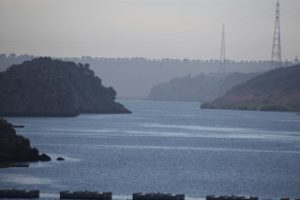
At Esna (for example), the Nile, depositing its annual negligible ¼ inch of silt, was able (over 2 millennia) to virtually bury the temple at Esna, with the modern town of Esna now sitting higher than the roof of the temple. [See photographs in Appendix A.]
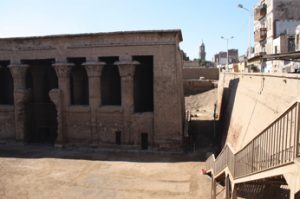
This temple that we see here was built on top of earlier temples because of prior cumulative annual siltation deposits.
Several other locations throughout Egypt show the impact of the siltation problem at several surviving temples, such at Edfu, Luxor, and Abydos. [See photographs in Appendix A.]
Much further inland and far away from the River Nile, we find another example at Abydos, where the very old massive structure called the Oseirion is located next to the New Kingdom temple of Osiris, which was built by King Seti I (1333–1304 BCE) and his successor Ramses II. This Oseirion structure is located much below the elevation of the New Kingdom’s Temple of Osiris and is partially submerged underneath the groundwater table. The Ausarian structure’s foundation is cut many feet below the present level of the water table, which has risen some 20 ft. (7 m) since New Kingdom times.
It should be noted that many pharaohs have inscribed their names on buildings that they never built. Therefore, just because Seti I inscribed his name on some parts of the Oseirion building, this does not make him the builder of the Oseirion.
The tremendous difference in elevation between the Ausarian and Seti’s Temple, as well as the dramatic difference in style between the two, suggest to many scholars that the Oseirion is a much older building. [See photographs in Appendix A.]

The evidence at the Oseirion is consistent with the evidence at Giza and elsewhere regarding the greater antiquity of Egyptian civilization.
2. The Point Of Beginning
Herodotus reported that he was informed by Egyptian priests that the sun had twice set where it now rose, and twice risen where it now set. The statement indicates that the Ancient Egyptians counted their history for more than one zodiac cycle of 25,920 years.
The zodiac cycle of 25,920 years comes as a result of the wobbly rotation of the earth, which does not spin true upon its axis but more like a slightly off-center spinning top. [See diagrams and explanations of the fundamentals of this phenomenon in Chapter 11.] This motion is called ‘precession’. As a consequence of the wobble of the earth upon its axis, the vernal equinox each year rises against a gradually shifting background of the zodiac constellations.
The precession of the equinoxes through the constellations gives names to the twelve zodiac ages. It takes roughly 2,160 years for the equinox to precess through a zodiac sign. Thus, it takes some 25,920 years for the spring equinox to traverse the full circuit of the constellations of the twelve zodiac signs. This complete cycle is called the Great/Full Year.
Therefore, Herodotus’ statement about the sun setting/rising where it now rises/sets would mean that the Egyptians counted their history back for more than a complete zodiac cycle. The precessional cycles of the equinox were observed and recorded in Ancient Egypt [See Astronomy in chapter 11].
Our present zodiac cycle (Great/Full Year) began with the Age of Leo the Lion, as follows:
Age of LEO: 10948–8788 BCE
Age of CANCER: 8787–6628 BCE
Age of TWINS: 6627–4468 BCE
Age of BULL: 4467–2308 BCE
Age of ARIES: 2307–148 BCE
Ancient Egyptian history extended to a complete zodiac cycle of 25,920 years, plus a partial zodiac cycle, between 10948 BCE and the end of the Age of Aries, when Ancient Egypt lost its independence. Thus, the antiquity of Ancient Egypt is [25,920 + (10,948 – 148)] = 36,720 years old. We will reaffirm this antiquity by another set of calculations, later on.
That the Ancient Egyptian civilization is over 36,000 years old—and by extension, that life on Earth is that old—goes against Christian/Western establishments.
Both have predetermined that life on Earth is about 5,000 years old. As a result, it has been continuously repeated that the Pharaoh Mena (c. 31st century BCE) is reputed to have “unified Egypt” and began Ancient Egyptian civilization.
This repeated arbitrary and unfounded assertion about the Pharaoh Mena (Menes) being the beginning of Ancient Egyptian history is contrary to the evidence. The Greek and Roman writers of antiquity, basing their accounts on information received either first- or secondhand from Egyptian sources, claimed a far greater antiquity for the Egyptian civilization than what was arbitrarily established by academicians.
The chronology of the Ancient Egyptian Pharaohs since the time of Mena basically came from Manetho in the 3rd century BCE. Manetho’s work has not survived—we have only the commentaries on it by Sextus Africanus [c. 221 CE] and Eusebius of Caesarea [c. 264–340 CE].
According to Eusebius, Manetho ascribed great antiquity to Pharaonic Egypt with the age of Ancient Egyptian antiquities of 36,000 years, which is consistent with the accounts of Herodotus. This is in a general agreement with other accounts and evidential findings, such as Diodorus of Sicily [Diodorus I, 24] and the Ancient Egyptian document known as the Turin Papyrus—an original Egyptian document dating from the 17th Dynasty [c. 1400 BCE].
The physical evidence also supports this remote antiquity of Ancient Egypt despite the fact that so much archeological evidence from such remote times has been buried below the present groundwater levels due to the phenomenon of the rising Nile Valley [as explained in Appendix B, with supporting photographs]. Evidence remains, from many Ancient Egyptian texts, temples, and tombs, which corroborates the accounts of the Greek and Roman writers. For example, many temples throughout Egypt make reference to being originally built much earlier than its “dynastic history”. The texts inscribed in the crypts of the temple of Het-Heru (Hathor) at Dendera clearly state that the temple that was restored during the Ptolemaic Era, based on drawings dating back to King Pepi of the 6th Dynasty (2400 BCE). The drawings themselves are copies of documents that are thousands of years older (from the time of Servants of Heru). The text reads:
The venerable foundation in Dendera was found in early writings, written on a leather roll in the time of the Servants of Heru ( the kings preceding Mena/Menes), at Men-Nefer (Memphis), in a casket, at the time of the lord of the Two Lands… Pepi.
Due to the rising elevation of Egyptian land, as explained earlier, several Ancient Egyptian temples needed to be elevated, as confirmed by Herodotus and the physical evidence throughout Egypt. Even though a few Ancient Egyptian temples were restored during the Greco-Roman period, they were all rebuilt according to Ancient Egyptian plans, symbols, deities, figures, etc. that were found in numerous temples and tombs throughout the country long before the Greco-Roman era.
3. The Age Of Leo And The Sphinx
Our present zodiac cycle began with the Age of Leo [10948–8788 BCE], and is represented by the Great Sphinx of Giza, with its human head and the body of a lion. Both the historical and the physical evidence at the Sphinx’ site indicates its remote age, despite the common (but groundless) notion that the Sphinx was built somewhere between 2520–2494 BCE, during the reign of Khafra (Chephren).
Herodotus, who wrote about the pyramids of Giza and the builder Pharaohs (including Khafra) in detail, never attributed the construction of the Sphinx to Khafra. Other writers of antiquity who wrote about the Sphinx never attributed it to any particular pharaoh.
A powerful piece of physical evidence regarding the antiquity of the Great Sphinx is the Ancient Egyptian stela commonly known as the “Inventory Stela”, which was found in Giza in the 19th century. This stela describes events during the reign of Khufu [Cheops 2551–2528 BCE], Khafra’s predecessor, and indicates that Khufu ordered the building of a monument alongside the Sphinx. This means that the Sphinx was already there before the time of Khufu and therefore could not have been built by his successor, Khafra [2520–2494 BCE].
Since the “Inventory Stela” contradicted the Western academicians’ prior assertions regarding Khafra being the builder of the Sphinx, they dismissed the stela on the basis that its stylistic features appeared to be from the New Kingdom [1550–1070 BCE]. This is not a sufficient cause to dismiss it, since there are numerous stelae and texts from the Old Kingdom [2575– 2150 BCE] that were later copied in the New Kingdom, and no one dismissed their authenticity. People everywhere copy older documents all the time so as to maintain their knowledge for future generations.
Notwithstanding the clarity of the text on the inventory stele which stated that the Sphinx was already there when Khufu built the Great Pyramid, some insist Khafra was the builder of the Sphinx, which is based on two highly questionable premises:
- A stele that was attributed to the Pharaoh Twt Homosis (Tuthomosis) IV [1413–1405 BCE], which was placed between the paws of the Sphinx. It is a long text, and some claim that the name of Khafra (Chepren) appears on it, even though the text surrounding said name was illegible. It is basically a desperate attempt to place the name Khafra at the site of the Sphinx.
- There is a causeway between the Pyramid Temple of Khafra and the Valley Temple, of approximately 1650 ft. [500 m] long. Even though there are no inscriptions on the Sphinx or in this temple, Western academia asserted that the presence of the causeway is sufficient evidence of some kind of a connection with Khafra.
- Later excavations found a number of statues in this temple which were claimed to “resemble” the head features of the Sphinx. However, when the facial profiles of the statues were superimposed on the Sphinx’s face profile, there was no match whatsoever.
Even if we concede to these false premises of a name on a stele or unrelated statues, or the presence of the causeway; at best, there will be a conclusion that Khafra may have been the last pharaoh to restore the Sphinx before Twt Homosis IV, more than 1,000 years after the time of Khafra.
The physical evidence at the site of the Sphinx supports its antiquity of belonging to the zodiac Age of Leo.
The original site where the Sphinx is located was a gently sloping plain with an outcrop of harder rock. The main features of the Sphinx are comprised of different geological conditions, as follows:
- The head of the Sphinx was carved out of this outcrop, of a hard strata which is resistant to the effects of the natural elements.
- The body of the Sphinx was formed by quarrying away the stone from all around the soon-to-be body. The body of the Sphinx was made of a softer limestone strata, which in turn consists of alternate harder and softer layers. These alternate layers are visible on site as weathered corrugation, which is about two feet deep into the bedrock.
- The base of the Sphinx, as well as the bottom of the original quarry site, are made of a harder limestone, which is resistant to the effects of the natural elements.
Since the body of the Sphinx is located in a hollow, it takes less than 20 years to fill it and totally cover the body. With the exception of the last century or so, the Sphinx has been covered by sand since the time it was created, thousands of years ago. Therefore, the Sphinx was protected from weathering exposure to wind and sand. However, there is a two-foot deep, smooth erosion on the wall of the excavated hollow (around the body of the Sphinx), with identical erosion patterns on the body of the Sphinx. Obviously, both the rock face and the Sphinx were carved before this severe weathering took place.
Many academicians have resigned themselves to the fact that the erosion to the body of the Sphinx was caused by water effects. The question becomes: What water caused this peculiar erosion pattern? That groundwater has caused such erosion must be dismissed, since it is estimated that the groundwater table was 30 ft. [9 m] lower in Khafra’s time [2520–2494 BCE] than its present level. In other words, it is impossible for groundwater to have caused the erosion of two-foot-deep channels into the body of the Sphinx and the walls of the quarry pit.
As explained at the beginning of this chapter, over the course of thousands of years, the inundation of the Nile had gradually deposited additional silt onto the ground of the Valley. Whenever the ground rises, so does the groundwater table. Therefore, the evidence is overwhelming against the groundwater theory as the cause of erosion at the Sphinx site. There is no other rational answer except that water erosion occurred at the end of the last Ice Age [c. 15,000–10,000 BCE]. Geologists agree that Egypt was subject to severe flooding at the end of the last Ice Age.
Another powerful piece of evidence regarding the antiquity of the Sphinx is the revelation of a recent drill hole in front of the ruined temple of the Sphinx (located in front of the Sphinx, and closed to the public) which revealed the presence of red granite at a depth of 54 ft. [16.5 m]. Granite is not native to northern Egypt and could have only come from Aswan, over 1,000 miles to the south. The presence of granite at such a depth is an additional proof of construction activities much earlier than 3000 BCE, when the ground elevation was 54 feet [16.5 m] below our present times.
In conclusion, the overwhelming physical and historical evidence, as detailed above, leads us to the rational conclusion that Khafra did not and could not have built the Sphinx—but he was one of many who restored it. Naturally, Ancient Egyptian monuments needed to be restored every few decades/centuries. The evidence at the Sphinx of Giza shows it to be the Ancient Egyptian mark of the zodiac age of Leo the Lion—c. 13,000 years ago.
Various photographs in support of the text of this subchapter are to be found in Appendix B of this book. The photographs will show:– Sphinx—General site. The original site where the Sphinx is located was a gently sloping plain with an outcrop of harder rock.– Sphinx—Head of Sphinx
– Sphinx—General site The original site where the Sphinx is located was a gently sloping plain with an outcrop of harder rock.
– Sphinx—Head of Sphinx
– Sphinx—Hard base of sphinx’ pit
– Sphinx—erosion on body
– Sphinx—erosion on walls of Sphinx’s pit
– Sphinx—erosion patterns on body and hollow
– Sphinx—natural protection from wind and sand
– Sphinx—early 19th century
– Sphinx—Similar erosion patterns to body of the Sphinx at The Pyramid Temple of Khafra stands 150 ft. (46 m) above the plateau. There was definitely no groundwater in the case of this temple. So how do we explain the similar erosion pattern? There is no other rational answer except that the water erosion occurred at the end of the last Ice Age c. 15,000–10,000 BCE.

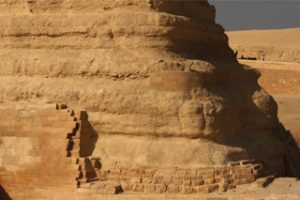
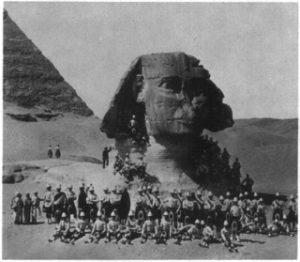

[An excerpt from Ancient Egyptian: Culture Revealed, Second Edition by Moustafa Gadalla]
https://egyptianwisdomcenter.org/product/ancient-egyptian-culture-revealed-second-edition/


